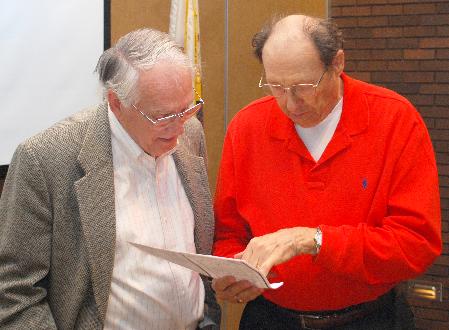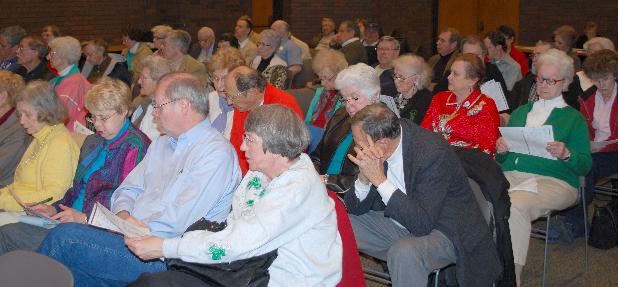
The April 2010 issue of the Historico is now online as a pdf.
|
Have a Sangamon County history question? |
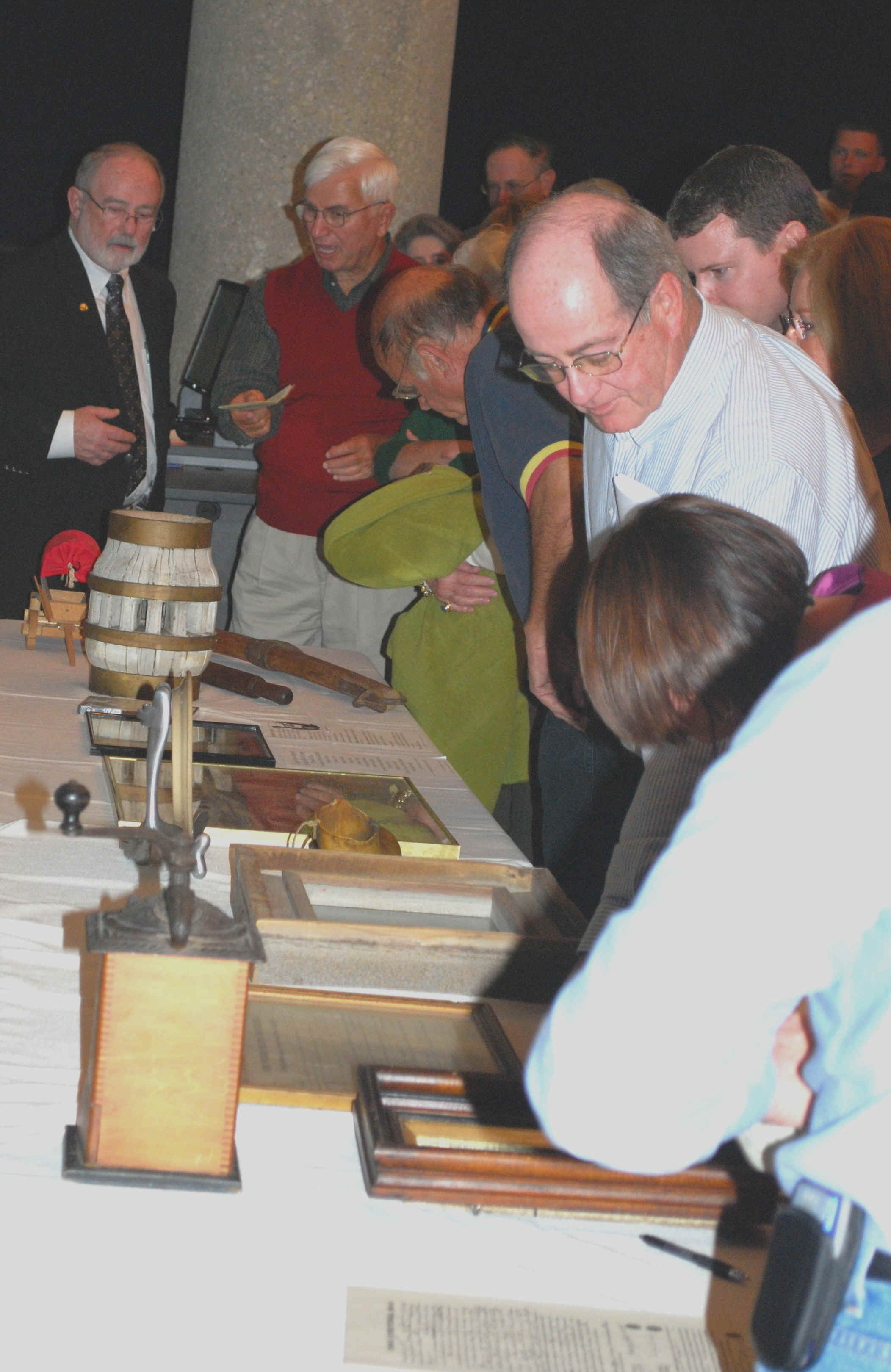 (posted
April 20, 2010)
(posted
April 20, 2010)
Donner Family Talk Draws SRO Crowd At UIS
Library
There wasn't
a seat to spare at the University of Illinois Brookens Library Auditorium
Tuesday evening, April 20, as an overflow crowd filled the room to hear Sangamon
County Historical Society board member Don Springer talk about the trials and
tribulations of the famed Donner Party.
Springer
is the great, great, great, great grandson of George Donner, who was chosen to
lead the wagon train over the final 1,000 mile portion of the historic journey
in which nearly half the party perished after becoming trapped in a winter
blizzard in the Sierra Mountains. George Donner and four other members of the
family were among the victims.
With his brother Bill and other descendents of the
Donner family in the audience that topped 220, Springer provided lesser known
details about the Donners prior to settling in Springfield. He also reflected on
the motivation behind their decision to leave Springfield in 1846, after 30
years of residence in Sangamon County. Springer also provided insight into the
hardships the wagon train faced in opting for an alternate route to California
that held promise for a shorter route but actually jeopardized the trip. After his talk, audience members (above, left)
had a chance to look at some of the documents and artifacts related to the
Donner Party. Springer (top left, in photo) and his brother have donated books,
reference materials, and memorabilia to the Library in an effort to make it a
full resource of Donner history for researchers, students, and others. The
Donner materials are usually housed in the Library's Archives and Special
Collections Department.
The
free program was co-sponsored with the Friends of Brookens Library and the
University's Engaged Citizenship Common Experience program. A reception followed
the presentation. If you missed Springer's presentation, you can watch it online
by
clicking
here.
(posted April 15, 2010)
Iles
House Draped in Bunting to Mark Mourning Days for Abraham Lincoln
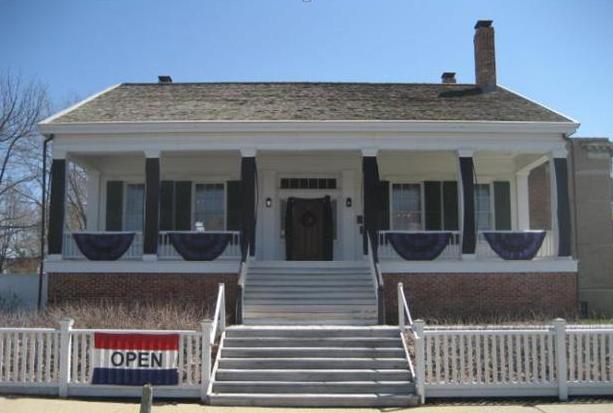
As was the custom at the time of Lincolnís death, the front porch of
the Elijah Iles House in Springfield has been draped in bunting of black and
purple for the mourning period of President Abraham Lincolnís death, April 15
through May 4.
One hundred and forty-five years ago, President Abraham
Lincolnís funeral procession, after passing the Lincoln Home, proceeded along
Cook Street from Eighth to Fourth streets and would have passed on the north
side of the Iles House, then the Robert Irwin residence, when it was located at
its original site.
Elijah Iles served as one of the pall bearers on that
day of the burial services. The 69-year-old Iles walked the route to Oak Ridge
Cemetery as did the others on what was said to have been a very warm May day.
(posted April 11, 2010)
New Berlin Area Historical Society
Hosts April 18 Talk
by Taylor Pensoneau on "Gangsters of Southern Illinois"
"Gangsters of Southern Illinois" will be the topic of a Sunday
afternoon program of the New Berlin Area Historical Society scheduled for 2
p.m., April 18 at Capone's Hideout, 201 W. Illinois St., New Berlin. The event
is free and open to the public.
Southern Illinois historian and local author
Taylor Pensoneau will be speaking about The Shelton Gang and Black Charlie
Harris, notorious Pond Creek outlaws who dominated life in rural Wayne County
and other parts of the state from the 1920s to the early 1950s. All made
headlines throughout the nation, and Harris eventually landed on the FBI's 10
Most Wanted list.
Pensoneau of New Berlin is the author of six books,
including "Brothers Notorious: The Sheltons," " Dapper and Deadly
- The True Story of Black Charlie Harris," and "The Summer of
'50." These three books will be available for purchase as a fund-raising
event for the society.
The afternoon will provide a fun opportunity for all
history and gangster buffs to participate in a "Gangster and Pals
Rendezvous." In keeping with the theme, clothing from the Roaring 20s and
the 1930s will be worn, and vintage vehicles will be on display. Those attending
are encouraged to participate in the fun by dressing in vintage attire. Drinks
will be available, and light refreshments will be served.
Tickets can also be purchased in advance from
Capone's Hideout for a murder mystery dinner theatre following the afternoon's
event.
(posted March 16, 2010)
|
"How Illinois Became A State" Talk Draws Full House
|
(posted February
16,2010)
February 16 Audience Tops
100!
Railroad Historian's Power Point Show
Details
Rich History of Interurban Here

Railroad Historian
Dale Jenkins speaking to the Society on Tuesday, February 16.
More than 100 people
turned out for a Society-sponsored talk and power point show Tuesday, February
16 that traced the rise and fall of Illinois Traction System, once this area's
most popular commuter and freight rail service. The meeting was held at
the Lincoln Public Library in Springfield.
In
his opening remarks, railroad historian Dale Jenkins--who grew up about a block
from the Illinois Traction Systemís Springfield terminal off Clear Lake Avenue--
recalled that as a very young child, he enjoyed watching the Interurban trains
go by. Then he discovered he could stop an oncoming train "just by sitting
on the tracks. " That prompted a visit from a railroad detective, Jenkins
said, who issued his mother a stern warning to keep her son away from the rails.
It
didn't work out that way.
After
high school, Jenkins joined the Illinois Traction System as a rail road police
officer, eventually succeeding the very railroad detective who admonished him as
a child.
Throughout
the hour-long presentation, the audience sat in rapt attention, occasionally
oohing and ahhing as Jenkins projected dozens of historic photos showing the
rich interiors of the passenger cars that took commuters back and forth between
cities, towns, and small villages across Central Illinois. He also showed photos
of passenger terminal buildings and rail lines that ran through Springfield as
well as a map of the route of a sister freight line that looped around the
outskirts of the city to avoid local regulations that would have otherwise
hampered its operations.
Passenger
service on the 550-mile electric interurban
rail line operated here from 1895 through the mid 1950s, bringing back memories
for some audience members who, in a question-and-answer session that followed
his talk, asked Jenkins about specific sites they remembered seeing as children
riding on the Interurban. That prompted Jenkins to show an additional set of
then and now photos, including one of a large garden at Starnes, where several
rail lines crossed. "They had gardens and walks, even a band," said
Jenkins, pointing to the spot now fenced and covered with underbrush that had
been remembered by the Interurban traveler.
In its heyday, the
interurban was the most convenient way to travel and ship freight at at time
when Central Illinois had dirt roads that disappeared in winter storms, turned
muddy in spring rain, and dusty in summer. But the growth in automobile
ownership and paved roads signaled the end of commuter service, Jenkins
explained. By
the time it ceased operations in 1981, it had become a completely diesel powered
freight-only service.
Jenkins,
who now lives in Decatur, worked for the line for 40 years, 37 of them as a rail
road police officer. He is founder and president of
the Illinois Traction Society, a group that is preserving the history of the
Illinois Terminal Railroad and its predecessor lines including the Illinois
Traction System and has also written a book about the line. He and
his wife Judy are volunteers at the Monticello Railway Museum which features
displays of rail cars and other equipment as well as steam-powered train rides
on weekends and holidays from May through October. Though he normally serves as
a conductor, Jenkins and his wife both hold engineer licenses.
On
behalf of the Sangamon County Historical Society, director and program committee
member Roger Whitaker presented Jenkins with a year's membership in the
organization.
(posted February 9, 2010)
Abraham Lincoln Funeral Train Monument Unveiled February 9
Station Ceremony Draws Crowd, Media, Despite Snow
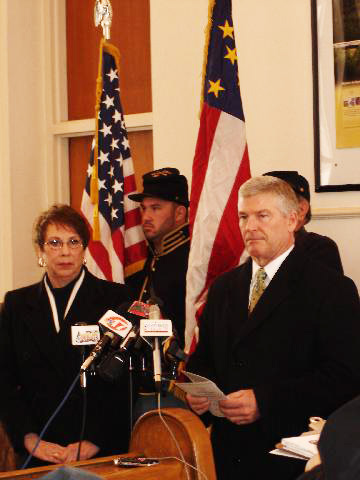
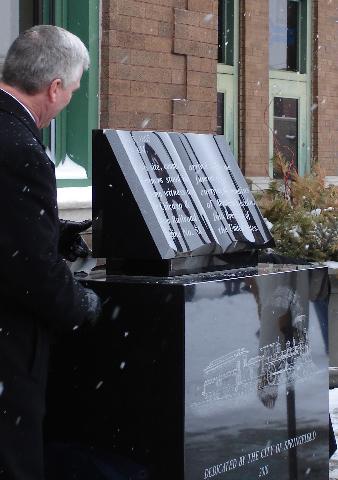
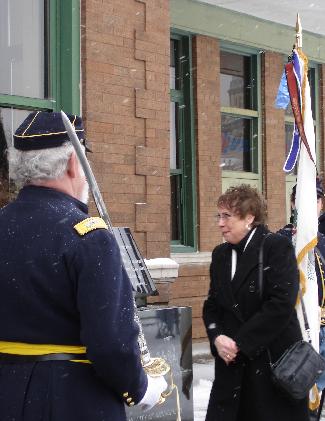

FROM LEFT: Spindell
listens as Mayor Davlin makes his remarks; Mayor Davlin looks at the
monument; Spindell gets a close up the honor guard fires
to the roll of the drums. BELOW: Local media were out in force to cover the
event.
An
unveiling ceremony for the
new Lincoln Funeral Train Memorial Monument at Springfield's Amtrak Station,
drew a large crowd of onlookers as well as the media Tuesday morning, February
9, despite snow that blanketed the area overnight and continued into the
day.
The site, on the west side
of the stationhouse at Third Street and Washington, marks the spot where the funeral train arrived in
Springfield on May 3, 1865, ending a 14-day, 1,700 mile journey from Washington,
D.C.
In a brief ceremony that started inside the
building, Springfield Mayor Tim Davlin praised Katie Spindell who drove the
effort to have some type of historic marker placed at
the  station that would show where the train made its final stop. Spindell
thanked the Mayor "for having enough faith in me and saying yes" to
the momument project.
station that would show where the train made its final stop. Spindell
thanked the Mayor "for having enough faith in me and saying yes" to
the momument project.
Another
speaker, James Cornelius, curator of the Abraham Lincoln Presidential Library
and Museum in Springfield, noted the relationship between Lincoln and railroads,
on which Lincoln frequently traveled. As a lawyer, Lincoln handled many cases
involving Illinois railroads, serving as both a prosecuting and defense
attorney, he said. As President, Lincoln recognized the importance of the
railroads to the Northern cause, creating the Military Rail Road in 1862 to
support the war effort. By the end of the Civil War, the United States had the
largest rail system in the world, he noted.
Led by two units of Civil War reenactment groups
in full uniform, the ceremony then moved outdoors where Mayor Davlin and
Spindell unveiled the monument followed by a ceremonial volley of rifle fire.
* * *
Spindell, a Sangamon County
Historical Society member, designed the three foot wide by five foot high black polished
granite monument that was assembled by Arnold Monument and includes an etched illustration of the Chicago & Alton rail-road
Engine 58 that pulled the funeral car from Union Station in Chicago to
Springfield. Engine 58 was draped with flags intertwined with crepe and bunting
and other symbols of mourning. Illinois artist Elizabeth Mattingly Thacker hand
etched the drawing onto the monumentís granite base.
Spindell, a member of the
board of the cityís International Visitors Commission, had for the past several years provided tourists and dignitaries with
information about Springfield. She frequently found herself being asked about
the location of the funeral train arrival site at what is now the Amtrak
station. "Over the years, thousands--and I do mean thousands--of tourists
asked me where the funeral train arrived and were disappointed to discover it
wasnít designated with some type of monument or marker," said Spindell in
recent Historico interview.
The Lincoln Funeral Train
attracted some eight to 10 million mourners along its route from Washington D.C. through
Maryland, Pennsylvania, New York, Ohio, Indiana, and into Illinois. Markers and
memorials along the route can be found in every state.
Spindell, who spent
months researching the funeral trainís route, had sought a memorial that she
said would be "elegant, simple, dramatic, and somber." The monument
was installed at the site in December, awaiting for its unveiling.
Beaumont, Springer, Catlin Tapped as Directors for Society's Board
Three area residents have been appointed directors of the Sangamon
County Historical Society to fill vacancies on the board. They are James H.
Beaumont and Don Springer, both of Springfield, and Donna Catlin of
Sherman.
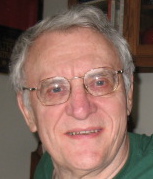 Beaumont, who retired as vice-president of the Illinois State Chamber of
Commerce in 2002, has long ties to this area. Born and raised in Decatur, his
father, James, was born and raised in Springfield in a house on Eighth Street,
south of the Lincoln Home.
Beaumont, who retired as vice-president of the Illinois State Chamber of
Commerce in 2002, has long ties to this area. Born and raised in Decatur, his
father, James, was born and raised in Springfield in a house on Eighth Street,
south of the Lincoln Home.
A graduate of Colgate University in
Hamilton, New York, Beaumont earned a masterís degree in journalism from
Columbia University in New York City, and a masterís degree in public
administration from the University of Illinois at Spring-field. Following
graduation from Columbia, Beaumont worked as a reporter for the daily Des
Moines Register, Iowaís largest newspaper, the first of what
would be three separate vocations.
When a family friendís job offer provided
an opportunity for him to move back to Decatur, he took it, even though it meant
switching careers and going back to school--to Northwestern--to receive training
as a stock-broker. Beaumont began his third career in 1972, this time as an
Illinois State Chamber of Commerce exec, moving to Springfield
with his wife, Mary, and children. Family members of the Society, today the
Beaumonts have two married sons and five grandchildren.
In 1994, he was named outstanding chamber
executive of the year by the Illinois Association of Chamber of Commerce
Executives. The award recognized long-term professional career achievements of
the candidate including experience, training and education, and service to IACCE
and other professional organizations.
A self-admitted history buff, he is particularly interested in the Civil War
Era, his desire to learn more piqued by a course he took at UIS taught by the
late Phillip S. Paludan, a leading authority on the life and presidency of
Abraham Lincoln. "I was fortunate to take Dr. Paludanís course on the
Civil War Era as a senior learner at UIS the last time he taught it, and Iím
still reading books to follow up on topics raised in that class."
Beaumont will serve
as a director until 2012, filling what remains of a three year term vacated by
Bill Minder.
* * *
Springer, a descendant of the famed
Donner family of Springfield, whose ill-fated journey west 164 years ago, has
become an integral part of the history of Americaís western migration, has
been a Life Member of the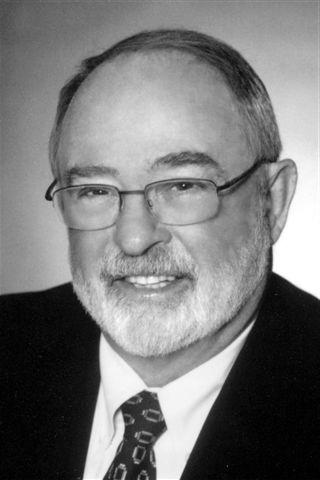 Society since 1966, serving on the board from 1998 to 2001.Abraham Lincoln lived
across the street from Springerís great-great grand-father, the Reverend
Francis Springer, who founded both Trinity Lutheran and Grace Lutheran churches
in Springfield and was the cityís first superintendent of schools.
Society since 1966, serving on the board from 1998 to 2001.Abraham Lincoln lived
across the street from Springerís great-great grand-father, the Reverend
Francis Springer, who founded both Trinity Lutheran and Grace Lutheran churches
in Springfield and was the cityís first superintendent of schools.
Springer will be
discussing the Donner Familyís Trials
of the Pioneer Trail, 1846 as guest speaker at the Societyís April
20 program meeting.
Springer is currently
a director of the Center for American Archeology and is a member of Sons of the
American Revolution. He is also a member of the American Business Club, the
Springfield Film Commission, and the University of Illinois Foundation. He and
his wife Karen have two children, a daughter, Paula. and a son, Douglas.
A financial advisor with Edward Jones,
Springfield, he has been in the field for 36 years and is a founder and charter
president of the Illinois Securities Industry Association. His hobbies include
travel, hunting, and bridge.
Springer will serve as a director until
2011, filling what remains of a two year term previously held by Jack Nevins.
* * *
 A native of Springfield, Catlin was raised in Sherman, attending local
schools there and in Williamsville before marrying in 1961 and moving to Normal,
Illinois.
A native of Springfield, Catlin was raised in Sherman, attending local
schools there and in Williamsville before marrying in 1961 and moving to Normal,
Illinois.
Before moving
back to Sherman 20 years ago, she and her husband Carl, a career Navy man,
traveled extensively around the world and lived in several states. But her love
of local and Sangamon County history never left, says Catlin.
When she returned
home, Catlin began what she describes as "my quest to find what history I
could for the growing village of Sherman," a time-consuming project. The
communityís village board and mayor have designated Catlin the honorary
"Sherman Historian."
Catlin will serve until 2012, completing
the three year term previously filled by Sarah Thomas.
Society
Gives Springfield, Pleasant Plains Schools Funds for History Projects
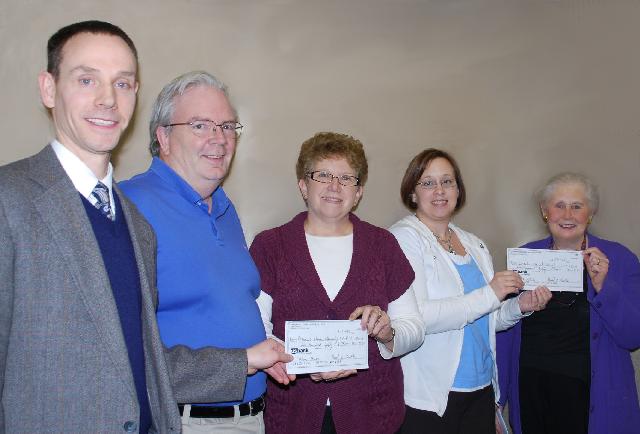
PROJECTS--ranging from buying books about Illinois and Sangamon County history for students at the Lincoln Magnet School to support their research for the Illinois History Fair to acquiring National Endowment for the Humanities reports on 19th Century Farming that will aid Pleasant Plains Elementary School sixth graders working on projects associated with the Pleasant Plains Historical Societyís restoration of the Clayville and Broadwell Inn--were awarded $250 grants from the Society to support their efforts. Checks were presented to teachers from each school at a special ceremony January 19 at the Chatham Public Library, held prior to the Societyís monthly program meeting. Society treasurer Paul Mueller (left) and Project Committee chair Elaine Birtch (right) share the moment with (from second left), Scott Morey, treasurer of the Pleasant Plains Historical Society, Pleasant Plains Sixth Grade Teacher Debbie Green, and Lincoln Magnet School teacher Jodi Mitts.
Contact the Sangamon County Historical Society
Phone: 217-522-2500 Email: schs@sancohis.org
All rights reserved. ©2010 Sangamon County Historical Society
